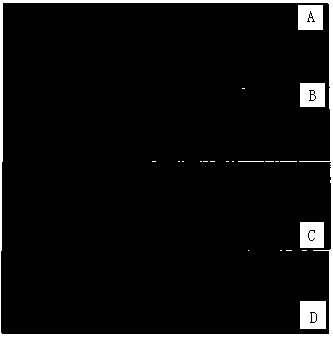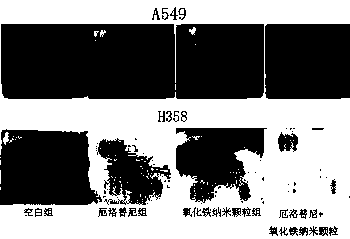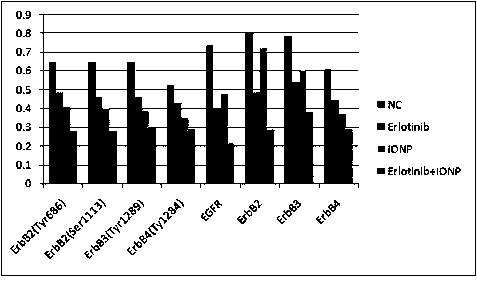Application of Iron Oxide Nanoparticles in the Preparation of Drugs for Improving Erlotinib Resistance
A technology of iron oxide nanometer and drug resistance, which is applied in the direction of drug combination, antineoplastic drug, bulk delivery, etc., can solve drug resistance and other problems, achieve high biological safety, far-reaching clinical significance and promotion, and enhance anti-tumor The effect of cell proliferation
- Summary
- Abstract
- Description
- Claims
- Application Information
AI Technical Summary
Problems solved by technology
Method used
Image
Examples
Embodiment 1
[0015] Embodiment 1: the making of iron oxide nanoparticles
[0016] Mix dextran, ferrous chloride, and ferric chloride at a mass ratio of 39.6:1:2.7, and react at 60°C for 1 hour, and slowly add an equal volume of ammonia water dropwise during the reaction. The reaction product was centrifuged at 12 000 r / min for 15 min, and the supernatant was taken and filtered with a 0.22um membrane filter. Continue at 12 000 r / min, remove the supernatant, wash with 150 mmol / L NaCl solution and resuspend.
[0017] Detection of the product: the diameter of the iron oxide nanoparticles of the product is below 10nm. In acidic conditions, the zeta potential of nanoparticles is positive; in neutral and alkaline conditions, the zeta potential of nanoparticles is negative.
Embodiment 2
[0018] Example 2: Anti-proliferation experiment of iron oxide nanoparticles on human non-small cell lung cancer A549
[0019] On the first day, 100ul of 5000 small cell lung cancer A549 cells were added to each well, and medium was added to make the volume 200ul. On the second day, after the cells adhered to the wall, different concentrations (2mM, 200uM, 20uM, 2uM, 200nM, 20nM, 2nM, 0.2nM, 0.02nM, 0.002nM) iron oxide nanoparticles treatment. Two days after treatment, 20 microliters of CCK-8 solution was added to each well. Continue to incubate in the cell culture incubator for 0.5-4 hours, and measure the absorbance at 450 nm.
[0020] Such as figure 1 As shown, different concentrations of iron oxide nanoparticles were used to treat lung cancer A549 cells, and the results showed that 2mM and 200uM iron oxide nanoparticles had a significant inhibitory effect on lung cancer A549 cells.
Embodiment 3
[0021] Example 3: Effect of iron oxide nanoparticles and erlotinib on the proliferation of human non-small cell lung cancer A549 and H358 cells
[0022] On the first day, 100ul of 5000 cells of non-small cell lung cancer A549 and H358 cells were added to each well, and culture medium was added to make the volume 200ul. On the second day, after the cells adhered to the wall, different concentrations of erlotinib (5uM, 10uM, 20uM, 40uM) and 200uM iron oxide nanoparticles treatment. On the corresponding days after treatment, 20 microliters of CCK-8 solution was added to each well. Continue to incubate in the cell culture incubator for 0.5-4 hours, and measure the absorbance at 450 nm.
[0023] Such as figure 2 and image 3 As shown, the combination of iron oxide nanoparticles and erlotinib inhibited the proliferation of human non-small cell lung cancer A549 and H358 cells. The results showed that iron oxide nanoparticles could significantly enhance the inhibitory effect of e...
PUM
| Property | Measurement | Unit |
|---|---|---|
| diameter | aaaaa | aaaaa |
Abstract
Description
Claims
Application Information
 Login to View More
Login to View More - R&D
- Intellectual Property
- Life Sciences
- Materials
- Tech Scout
- Unparalleled Data Quality
- Higher Quality Content
- 60% Fewer Hallucinations
Browse by: Latest US Patents, China's latest patents, Technical Efficacy Thesaurus, Application Domain, Technology Topic, Popular Technical Reports.
© 2025 PatSnap. All rights reserved.Legal|Privacy policy|Modern Slavery Act Transparency Statement|Sitemap|About US| Contact US: help@patsnap.com



